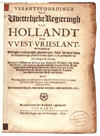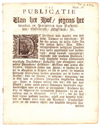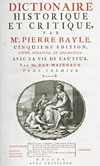1600-1700: Subdued Freedom I
The Dutch Republic and the printing city of Amsterdam
The 16th and 17th centuries saw the first great wave of relatively cheap printed texts in Europe, which helped to fuel the religious and political turmoil of these years. In a fragmented and divided Europe, the Dutch Republic was a popular place of refuge for commentators on politics and current affairs from other countries. These immigrants and their Dutch colleagues made eager use of the comparative freedom in the Republic in order to disseminate their ideas. Amsterdam profited from the immigration of often well-educated people and became the most important printing city in Europe.
The printing press became an important industry. News was a popular commodity for merchants, operators of merchant shipping, statesmen and religious leaders, and this led to the rise of newspapers. Much of the news was indeed 'hot news' and was able to damage interests, leading to corresponding conflicts.
On 20 December 1581 William of Orange issued an edict that required preventive censorship by the authorities. Henceforth, the place and year of publication, the name of the printer and of the author or translator had to be stated. In the subsequent years and decades this edict was repeatedly renewed and updated. From 1585 onwards the Dutch Reformed Church, in turn, started to use visitatores librorum (book inspectors) who supervised religious tracts due for publication. Enforcement proved to be a difficult issue for both secular and religious authorities. In the turbulent years 1618-21 (August 1618 saw a coup d'état by Prince Maurice, 1618-9 the Synod of Dordrecht) the States-General took a tighter hold of the reins. Yet preventive censorship, though still officially in force, was hardly exercised in the Dutch Republic.
This contrasted with other countries where a text had to be submitted to censores librorum (book assessors) before publication. In the Ottoman Empire the authorities even went a major step further and simply forbade the printing press itself, the instrument of production. In the Republic the principle of privilege was applied - the sole right to print something; this did not involve the obligation to submit a manuscript for approval before printing. If things threatened to get out of hand, the possibility of censorship after publication was available. This repressive censorship was characteristic of the Republic in the turbulent 17th century. It was not only the States-General who sometimes took severe action against printers and publishers, but also provincial and local authorities who, in the strongly decentralized and particularistic Republic, could decide for themselves whether and what they censored. In practice they were often circumspect and opportunistic.
Which texts were censored and forbidden? In the 16th century, when the Netherlands still formed part of the Catholic Spanish Empire, it was mostly 'heretical', i.e. anti-Catholic, works that were banned.
Following the uprising against Spain, the banned texts were also, or indeed chiefly, works that concerned the state and its security, that promoted political and religious discord, that were insulting to foreign heads of state, that brought domestic regents into discredit, damaged trade relations or offended the 'morals' of the land.
The 17th century was a highly turbulent period for the Republic. For many years the country was at war or on the brink of war with other European powers. The Republic also extended its colonial empire in this period, often by force of arms. Religious issues repeatedly served to raise tempers. Yet despite all censorship measures, the 17th century saw a lively trade in forbidden printed texts. Even well-known printers such as Blaeu and the Elzeviers broke or avoided the rules and they too proved highly inventive when it came to thinking up false names and places of printing. The Elzeviers, for instance, used 'Cologne, Pierre Marteau', a false name employed by several printers, and Blaeu used 'Eleutheropolis' (free town, i.e. Amsterdam) for a Socinian text. Socinians (and their printers) were regular victims of censorship. The followers of Faustus Socinus, a 16th-century Italian humanist who had moved to Poland and founded his own faith, with many adherents in the Netherlands, did not believe in the Holy Trinity, the divinity and resurrection of Jesus and also rejected predestination. These views were diametrically opposed to those of Calvinists and Catholics alike.
In spite of the possibility of censorship after publication, all things considered it was possible to print almost anything in the Republic. The exceptions, however, have received a great deal of attention. One well-known example is the severe punishment of Spinoza's follower Adriaen Koerbagh. In 1669 this freethinker died in an Amsterdam gaol, where a few months earlier he had commenced a term of ten years' imprisonment for spreading Spinozist and Socinian ideas.










